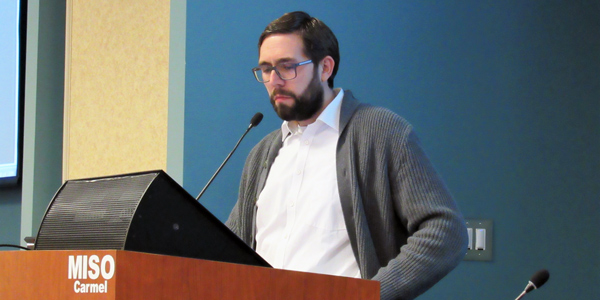By Amanda Durish Cook
CARMEL, Ind. — MISO’s Resource Adequacy Subcommittee will devote time this year to several projects focused on improving the RTO’s resource adequacy construct, stakeholders learned last week.
Key among the efforts: a continuing discussion on how to deal with the shifting availability of resources.
Speaking at a March 7 RASC meeting, Manager of Resource Adequacy John Harmon said the seven projects are the result of a draft work plan MISO began in January. They were prioritized based on previous commitments to stakeholders in 2017, the urgency of each project, and the staff and capital spending available to devote to each project. (See MISO Seeks To-Do List for Resource Adequacy Panel.)
Harmon noted that the RASC will naturally dedicate time to discussing the nearly completed proposal to create external resource zones for the RTO’s Planning Resource Auctions. (See related story, MISO Closing in on External Capacity Zones.)
Resource Availability and Need
The RASC’s 2018 priorities will also include a larger discussion on resource availability and need, a topic evolving from MISO’s former proposal to create seasonal capacity procurement requirements, a generally unpopular move among stakeholders.
MISO will now consult with stakeholders to determine whether it should revise current resource availability requirements and price signals in the face of shifting availability, itself a product of tightening supply, increased renewables, more frequent extreme weather events and an aging baseload fleet more susceptible to outages. RTO officials say the proposal is no longer as simple as applying separate clearing requirements to two-season and four-season capacity auctions.
The effort will also explore the possibility of MISO factoring the effect of outages during peak load into its loss-of-load expectation study in time for the 2019/20 planning year, which could boost the planning reserve margin requirement. MISO is planning to inform its modeling with an average of outages on peak during the last five planning years, translating to an average 729 MW in outages and a 0.6% increase in the reserve margin, Resource Adequacy Coordinator Ryan Westphal said. MISO’s current modeling assumes generation owners do not schedule any planned outages during the peak. (See MISO to Fold Outage Forecasting into Larger Resource Effort.)
“Zero seems we’re not modeling the reality — the risk — correctly,” said MISO Director of Resource Adequacy Coordination Laura Rauch.
“Current modeling practice could be relying on resources that might not be available. … These ought to be captured,” Westphal added.
Speaking on behalf of the Coalition of Midwest Transmission Customers, attorney Jim Dauphinais warned against “socializing the cost of planned outages” with an increased planning reserve margin if only a few units are the culprits of planning outages on peak.
“I disagree; we’re a risk-sharing insurance pool,” responded Consumers Energy’s Jeff Beattie, adding that generation operators agreed in MISO’s Tariff that even companies covering reliability with several smaller units would share risk with companies relying on a single large unit that carries more outage risk.
Westphal asked stakeholders to provide more feedback by March 21, noting that MISO would need to complete a proposal by June to allow it to model planned outages on peak in the 2019/20 planning year.
Other RASC priorities this year will include:
- Improving alignment between MISO’s loss-of-load expectation study and its annual resource adequacy survey with the Organization of MISO States;
- Discussing how energy storage resources could earn capacity accreditation;
- Discussing how behind-the-meter generation can fit into MISO’s resource adequacy construct;
- Deciding whether MISO should bar units on extended outages from offering into the capacity auction;
- Determining the best approach to potentially importing capacity from Ontario’s Independent Electricity System Operator into MISO.
Harmon said MISO plans to postpone until next year a project that would alleviate partial unit clearing, which occurs when the RTO’s algorithm clears a marginal offer on a pro rata basis, resulting in revenue shortfalls for resources that clear a fraction of their unforced capacity values.
The RASC will not focus on two other previous suggestions: developing forward capacity price indices and raising the PRA price cap above MISO’s approximate $250/MW-day cost of new entry (CONE). Harmon said MISO “has no role in bilateral markets” and “should not be involved in facilitating pricing information outside its markets.” He also said there’s no indication at this time that MISO’s cost of new entry needs to be raised because auction clearing prices are far from closing in on the CONE.




